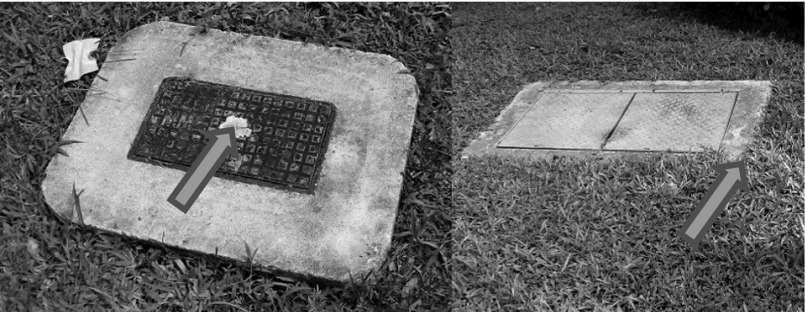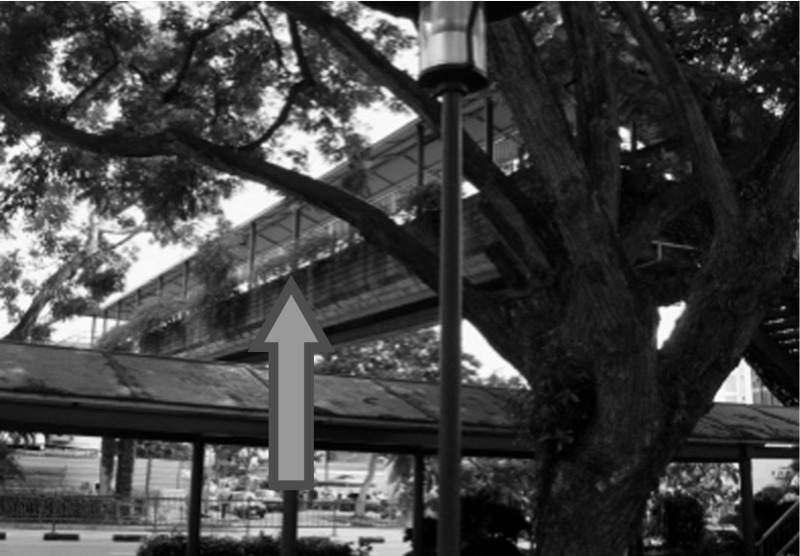Abstract
Singapore is known for its comprehensive vector control methods that keep mosquito populations at low levels in the urban, tropical, and green city-state. This report describes the measures taken by the National Environment Agency on the basis of observations of vector control and surveillance activities in residential areas, construction sites, and foreign worker quarters. The government-led active operations dealt not only with mosquito control but also social issues in urban residential buildings where people with varying preferences live, the responsibilities of the business sector, and the education of multi-cultural/lingual residents and foreign workers. The public health measures implemented in Singapore offer useful ideas to countries/cities that have not yet established vector control programs against mosquito-borne infectious diseases.
Keywords: vector control, urban, social responsibility, foreign worker, Singapore
Background
The urban, tropical city-state of Singapore is known to have successfully reduced vector mosquito populations to as low as 0.35% premise (house) index, i.e. the percentage of premises infested by Aedes larvae and/or pupae [1]. Although situated in the center of a region plagued by mosquito-borne infectious diseases, the vector control program of Singapore has led to moderate disease prevalence and/or quick control of domestic outbreaks [2]. The leadership of the National Environment Agency, Singapore (NEA, a statutory board under the Ministry of The Environment and Water Resources) is the key to deployment of an intergovernmental approach and promotion of the so-called “3P” partnership. The 3P partnership connects people (volunteers and grassroots organizations), the private commercial sector (service providers and professional associations) and the public sector (government agencies). The elimination of mosquito breeding sites has not been an easy task even for Singapore, because changes in vector behavior, exacerbated by the rapid urbanization and industrialization of the country, provide many additional potential breeding habitats. Moreover, the competence of a previously insignificant vector can suddenly increase due to a new disease, virus mutation, or other factor. For example, in early 2008 Singapore successfully contained the first domestic chikungunya fever outbreak mediated by peri-domestic Ae. aegypti. However, a larger and persistent outbreak in a less urbanized area occurred three months later. This outbreak was triggered by importation of a mutated virus, enabling Ae. albopictus to mediate efficiently. This vector was more active in outdoor environments. Consequently, the NEA revised the previous vector control strategy that had worked for Ae. aegypti to additionally target Ae. albopictus [3–5].
This paper aims to describe how vector control and surveillance operations are performed by the NEA using photographs and field observations conducted between September 2008 and March 2011. Singapore defines vector control as “the destruction, or the prevention of propagation or harboring of vectors” [6]. As Dengue and Chikungunya virus infections emerge and re-emerge globally, the NEA’s identification of mosquito breeding habitats and the resilient vector control shows the kind of public health measures that may be required to gain a similar level of control. This knowledge is relevant to countries/cities without effective vector control programs but with susceptible populations living in densely populated urban areas where vector mosquitoes are prevalent. Even such indigenous pathogenic viruses are unavailable to sustain transmission, importation of virus remains possible.
Inspection of Singapore Residential Areas September 11, 2008
In the island city-state, vector surveillance activities are usually conducted in the field in the morning before the heat of the tropical sun becomes unbearable. The weather was partly cloudy; temperature was 28°C at 9 a.m. and 30°C by 11:30 a.m.; and the relative humidity was 61 to 94% [7]. A senior manager of the NEA and I joined NEA officers on a visit to an area of private houses locally known as “landed properties.” A landed property area features a number of two-story houses (usually) and represents luxury in the compact republic where approximately 80% of the population reside in public high-rise apartments.
Counter-intuitively, the residents with a higher socio-economic status are more vulnerable to vectors because of their proximity to the ground. The percentage of premises breeding Aedes mosquitoes around landed houses has been consistently higher than other types of residence, i.e. public flats and condominiums [1]. Upon receipt of consent, the vector control team entered the gate. The residents were not obliged to cooperate with this regular surveillance, as they would during an outbreak investigation, but on this day there was not a single case where the NEA officers were denied entry. They were only unable to conduct inspections when the residents were away. The officers climbed the roof of each house to check the condition of gutters. If roof gutters are found to contain stagnant water, the NEA serves a letter requesting owners/residents to remove the gutters or to show that they are capable of maintaining the roof gutters in good condition. This is because rainfall trapped in gutters is an attractive egg-laying site for female mosquitoes. In compliance with the NEA’s community outreach efforts, none of the flower pots in gardens was found to have a plate under the bottom, another potential mosquito breeding site. The vector surveillance at the landed properties was followed by application of pesticide in water drains between houses and streets. Although the frequent tropical showers could potentially wash the insecticide away, the spraying operation was conducted as a precaution since some residents were away, leaving their houses uninspected. The extra caution was warranted because it was not rare to find some properties left unoccupied for long periods, and it often took more than two or three weeks to contact the owners. However, NEA officers are allowed to make a forced entry in shorter time if deemed necessary [8].
The next field of investigation was a nearby housing complex of affordable public high-rise apartment buildings. These public apartments are home to multi-racial residents, and each building of an apartment complex has several units on each floor (Photo 1). If the residents are not available during the day, the NEA makes appointments in the evening. As Photo 2 shows, residents of the tropical city-state of Singapore sometimes leave front doors open, while keeping metal or wooden gate doors locked, for air circulation. Since the corridors are in the outside open air, keeping the environment free of mosquitoes is an important prerequisite for the prevention of mosquito-borne infectious diseases. When the inspector realized that one resident was an aged Chinese Singaporean with a poor command of English, she spoke in one of the Chinese dialects instead of English while conducting the premise inspection. This was followed by a public education effort to remind the resident of precautionary measures. Multi-racial officers skilled in multiple languages are very helpful in out-reaching to the community.
Photo 1. .
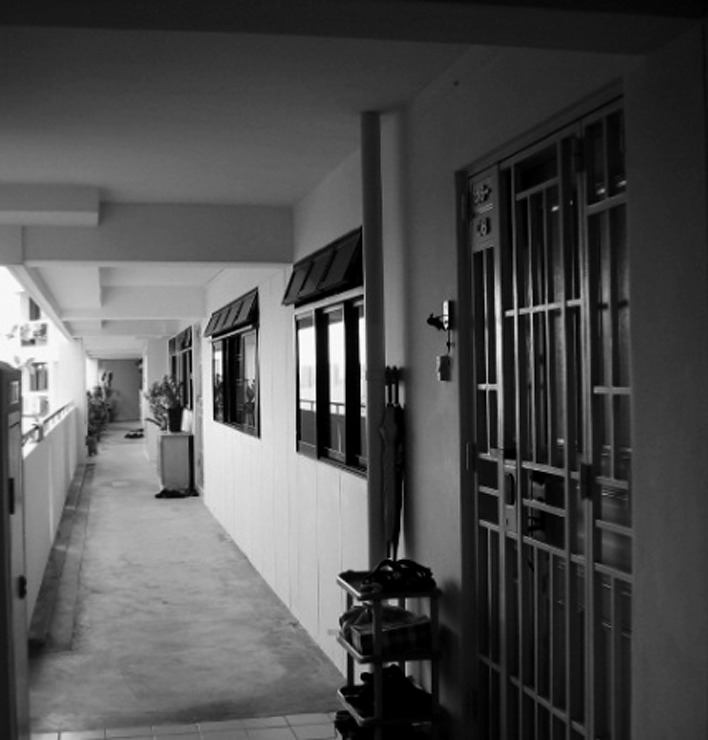
An open corridor in an apartment complex.
Photo 2. .
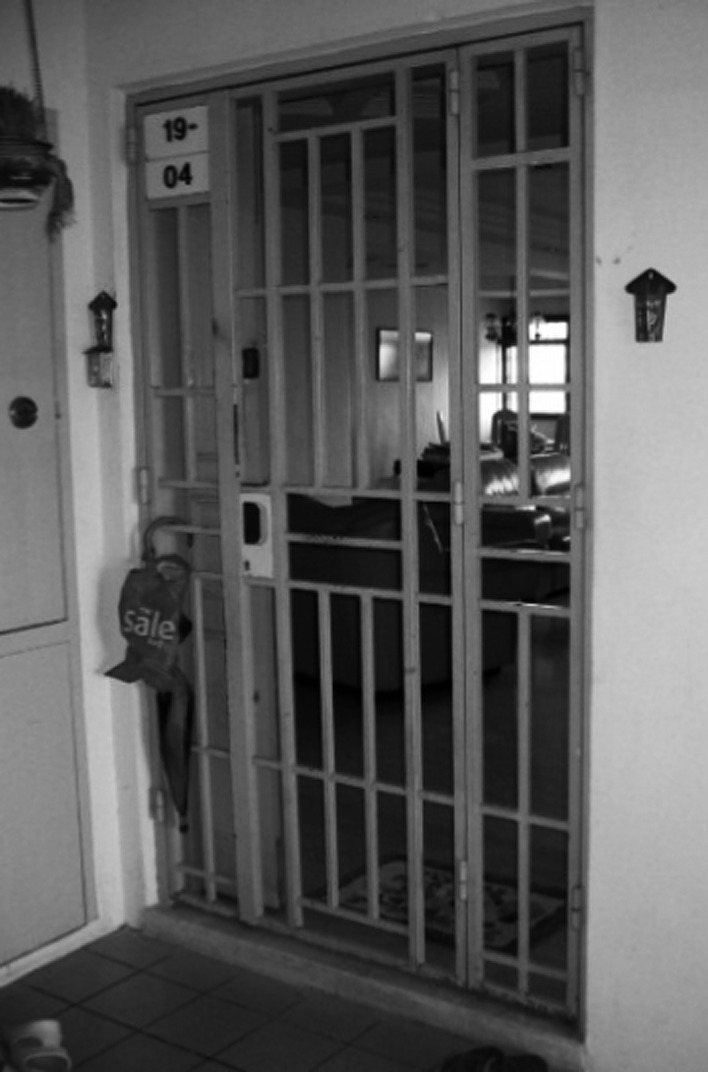
The gate door is locked while the main front door is left open for air circulation.
On the 19th floor, one NEA officer was carefully checking water pipes to determine if there was leakage from water tanks that once resulted in mosquito breeding. We then returned to the ground floor to check outside the building, beginning with the air conditioners. The NEA officers noticed a tray underneath an air conditioner on the top floor that tended to collect water. Photo 3 shows a gas chamber with a coin-size key hole filled (left), and the surrounding gaps of another tightly sealed (right). These alternations were made because rainwater previously fell through key holes and gaps, creating mosquito breeding sites. There were other areas around the building that required inspection, such as a multi-story car park. Not only does the basement ground tend to become wet with tropical rain, but the officers previously found a puddle near a fire-hose reel compartment serving as a mosquito breeding habitat. This was due to the unauthorized and irresponsible act of a resident who washed his car and left water dripping from the valves. The officers also inspected places where residents congregate for meetings and functions.
Photo 3. .
Utility chambers with a key hole and surrounding gaps tightly sealed.
We then left the estate to walk to a nearby bus stop, where trees and plants were growing and the ground was damp from a previous rainfall. The NEA senior manager explained that even flowerpots along the walking bridge can become sources for an outbreak of dengue fever (Photo 4). On the way to another public high rise apartment complex, my attention was called to red and white plastic safety barriers typically seen in construction sites throughout the country (Photo 5). These can be filled with sand for stabilization, but some contractors use water instead because it is easier to discard when relocating the barriers to another construction site. The plastic barriers gradually crack in the sun, and female mosquitoes lay eggs in the water between the cracks.
Photo 4. .
Flower pots along the walk bridge can be sources of mosquito breeding.
Photo 5. .
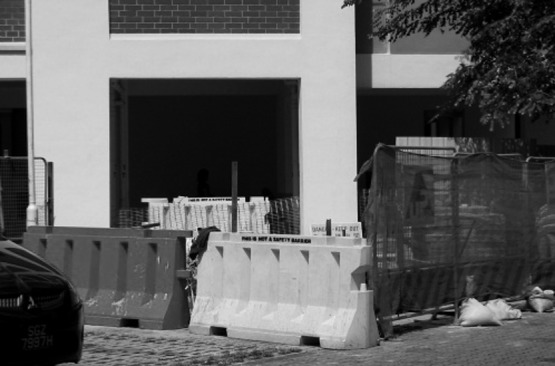
Safety barriers served as breeding sites for mosquitoes.
The NEA officers must pay additional attention to the different design and structure of each apartment complex. The residents of a particular complex we visited place numerous flower pots and planters along common corridors. Hence, black plastic oviposition traps (ovitraps) are placed in the corridors. An ovitrap is a monitoring tool that forms part of the NEA’s preventive surveillance regime. Checking them weekly is labor-intensive but enables the NEA to determine the prevalence and species of mosquitoes. Ovitraps attract a female mosquito to lay her eggs on the wooden paddle hatch of a water-filled cylinder container. The eggs fall through a wire mesh and develop into adults, but the adult mosquitoes are trapped inside the container, unable to escape through the mesh (Photo 6). Although the number fluctuates depending on the season, 2,000 to 3,000 ovitraps are deployed in areas at high risk across the country to monitor Aedes mosquito behavior. The geographical distribution of mosquito breeding sites is captured on geographical information system (GIS) maps for planning and analytical purposes. This strategy enables the NEA to preemptively remove mosquito breeding habitats in many areas even before cases of Dengue virus infection materialize.
Photo 6. .
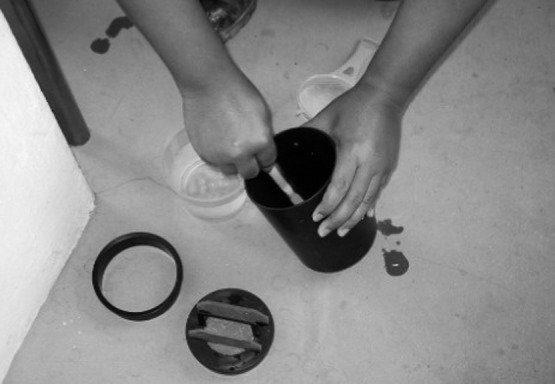
A complete ovitrap set: container, stopper, and float with paddles.
Surveillance at a Construction Site March 11, 2009
The Code of Practice of Environmental Control Officers (ECO) in Singapore lays out guidelines for contractors who perform work on construction sites [9]. Section 3.1 stipulates that contractors must employ a part-time ECO for construction projects exceeding Singapore $10 million and a full time ECO for projects exceeding $50 million [9]. Accordingly, each contractor hires pest controllers and appoints housekeeping staffs to clean the ground floor every morning and apply anti-mosquito oil twice a week. This measure is in compliance with the standard procedure recommended by the NEA and based on the Control of Vectors and Pesticides Act. A layer of “anti-malaria oil” is expected to suffocate larvae of a wide spectrum of mosquito species. The NEA checks construction sites once a month; violation can result in penalties, the most severe being an order to stop construction.
We visited a construction site where a private condominium complex comprising five 19-story buildings with four units on each floor was being built. The purpose of this visit by a team of two NEA officers and one pest controller hired by the NEA was to investigate places that might have been overlooked by the in-house pest control unit working for the contractor. The NEA officers started inspecting from the top floor, walking down one floor at a time and going through each unit before reaching the ground floor. Construction sites are treated with special caution because they are areas with a high potential for mosquito breeding in Singapore. Indeed, inherent conditions including water barrels placed on each floor to use when mixing cement exist in addition to water puddles created inside the units by the frequent tropical rain showers. A number of spots were hidden by materials stored on the ground floor (Photo 7, 8). The inspection also involved the surrounding areas, including places where construction workers from foreign countries stay. From experience, the NEA officers checked the bottom of the refrigerator and found stagnant water. The bottom tray must be cleaned periodically because Aedes mosquito eggs can develop into adult mosquitoes in less than a week under optimal conditions [10].
Photo 7. .
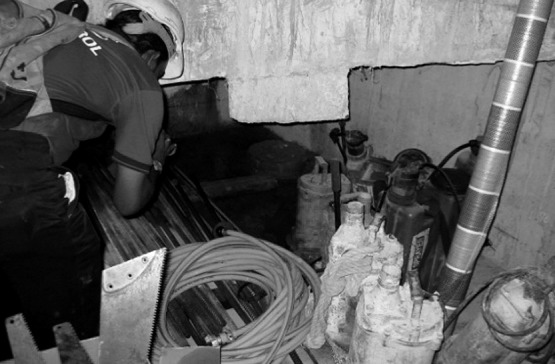
The NEA pest controller reaches into the bottom of the hidden place to inspect the areas where materials are kept on the ground floor.
Photo 8. .

Metal rods used to strengthen cement walls. Private in-house pest controllers are likely to miss this area because of the unstable foothold.
If larvae are found in the construction site, the NEA officers collect and send samples to the agency’s laboratory for investigation. If mosquitoes are found at a high density, the contractor is likely to be ordered to close down for a day or more and to perform thorough cleaning operation. And the NEA will return to ensure that the conditions are improved. Alternatively, the contractor of the construction site may be fined.
Insecticide Application at Temporary Worker Quarters March 2, 2011
As a precautionary measure, the NEA conducts a routine ultra-low volume (ULV) misting in worker quarters either monthly or once every few months with the cooperation of employers of foreign laborers working at various construction sites in the republic. If a cluster of Dengue or Chikungunya virus infection is reported among workers, the NEA will perform the ULV misting immediately. Photo 9 shows the equipment used for the application. Apparently, this method is better accepted by people because it is unlikely to leave oil stains on furniture and surface floors. We visited a three-story building with several rooms on each floor. The rooms with open windows and curtains commonly have no air conditioners and use electric fans. There are en-suite shower and toilet facilities in the back area while lockers and double-deck beds occupy the floor. Since each room is used by a different company hiring different nationalities of workers, notices in a variety of languages are posted on the entry doors. These outline rules in the worker quarters and give photographic examples of violations that may result in penalties.
Photo 9. .
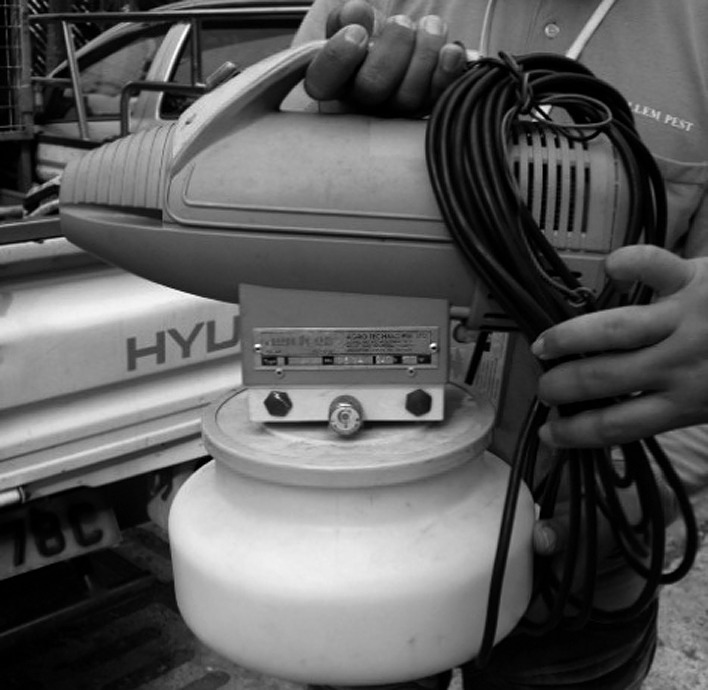
Pesticide (white color) is stored at the bottom of the ULV misting equipment.
During one time-consuming operation, we checked inside the room for mosquito breeding sources, and covered open food and/or drinks before applying the insecticide. The rear portion of each room was crowded with clothes, suitcases and other personal belongings, making it difficult to move between beds and lockers during the ULV application in each room. The operation team consisted of two contract workers with a supervising NEA officer. One worker wearing a thick protective mask used the applicator machine followed by another worker handling the long electric cable. The NEA supervisor behind the workers occasionally used a laser beam to direct their attention to areas in the room requiring ULV misting. The use of laser light made sense because the ULV machine was very noisy and inhibited verbal communication. Following the supervisor’s instructions, the first contract worker applied ULV under a bed, a place that he might otherwise have missed. Assigning at least one supervisor from the NEA is, therefore, essential to ensure good ULV operations. The misting continued into the back of the room and the shower/toilet areas adjacent to the room. All rooms on each floor were treated in the same manner. It is important to check inside drains for mosquito breeding outside the building.
Discussion
Most of the foreign workers engaged in construction work in Singapore are said to come from India, Bangladesh, and the People’s Republic of China. The NEA senior manager finds it helpful to speak to them in their native languages so the foreign workers can understand and feel comfortable. This has enabled the NEA officers to explain why controlling mosquitoes is so important. Understandably, the first priority of the workers is to earn as much money as possible before their contracts expire, so they tend to pay little attention to mosquitoes and to take fever lightly. Furthermore, these daily-paid workers hesitate to report sick because they fear losing their daily wages. This delays the detection of potential Dengue or Chikungunya virus infection cases, and late detection can eliminate opportunities to prevent subsequent transmission to colleagues and others.
Singapore’s vector control shows the importance of engaging large construction companies in public health efforts when some companies may choose to pay penalties instead of investing financial and human resources in vector control. Social responsibility in the business sector will remain a critical prerequisite for the success of public health interventions. Moreover, each vector control and surveillance operation is followed up with evaluation and feedback in Singapore, which provides the NEA with necessary vector and environmental data. The surveillance followed by evaluation and feedback helps improve the vector control strategies, allows evaluation of progress through public education, and eliminates mosquito breeding to preempt potential future outbreaks.
These examples of NEA operations may not be sufficient. This report introduces the proactive surveillance and control activities of the NEA involving 900 officers working in premises and outdoors island-wide (as of the year 2009) as well as pest control operators. However labor-intensive, the NEA’s surveillance and control activities must be performed to keep the vector mosquito population low in the urban environment. The NEA is aware that good vector control cannot be achieved by itself and continues to send a strong message through public education, insisting that responsible, careful, and cooperative individuals and communities are essential to maintain a healthy environment in Singapore. The activities we observed at residential areas, construction sites, and foreign worker quarters reflect the challenges that public health authorities may face in other countries/areas. They also show that controlled urban development, legal frameworks, public education, cooperation of residents, social responsibility of businesses, and multi-cultural/lingual communication with residents and foreign workers are needed for an effective vector control program.
Disclaimer: The views expressed herein are those of the author and do not necessarily reflect the views of the NEA.
Acknowledgements
This research was supported by Grants-in Aid for Scientific Research from the Japan Society for Promotion of Science (KAKENHI 24890092 and 19101010). I thank Mr. Choon Sian Tang, Senior Manager, Environmental Health Department of the National Environment Agency, Singapore for providing me with opportunities to observe the operations. I am especially indebted to Mr. G. Thurainadan, Senior Manager at the South East Regional Office for his detailed explanations during my observations.
References
- 1.Ministry of Health, Singapore Communicable diseases surveillance in Singapore 2009. Singapore: Ministry of Health, Singapore, 2010
- 2.Yoshikawa MJ. Dengue and chikungunya virus infection in Southeast Asia: active governmental intervention in Republic of Singapore. In: Tanaka K, Niki Y and Y Akatsuki, editors. Current topics of infectious diseases in Japan and Asia. Tokyo: Springer, 2010. pp. 59–77
- 3.Ng LC, Tan LK, Tan CH, Tan SSY, Hapuarachchi HC, Pok KY, Lai YL, Lam-Phua SG, Bucht G, Lin RTP, Leo YS, Tan BH, Han HK, Ooi PLS, James L, Khoo SP. Entomologic and virologic investigation of chikungunya, Singapore. Emerg Infect Dis 2009. Aug; 15(8): 1243–1249 [DOI] [PMC free article] [PubMed] [Google Scholar]
- 4.Yoshikawa MJ, Tang CS, Nishibuchi M. Incidence of chikungunya fever in Singapore: implications of public health measures and transnational movements of people. Trop Med Health 2010. Mar; 38(1): 39–45 [Google Scholar]
- 5.Tan CH, Wong PSJ, Li MZI, Tan SYS, Lee TKC, Pang SC, Lam-Phua SG, Maideen N, Png AB, Koou SY, Ng LC. Entomological investigation and control of a chikungunya cluster in Singapore. Vector Borne Zoonotic Dis 2011. Apr; 11(4): 383–390 [DOI] [PMC free article] [PubMed] [Google Scholar]
- 6.Republic of Singapore Vector control, the control of vectors and pesticides act (chapter 59)—[cited 2011 Sept 26]. Available from http://statutes.agc.gov.sg/non_version/html/homepage.html.
- 7.Weather underground —[cited 2011 Sept 27]. Available from http://www.wunderground.com/history/airport/WSSS/2008/9/11/DailyHistory.html?req_city=NA&req_state=NA&req_statename=NA.
- 8.The Straits Times NEA officers can conduct quicker forced entries.—[cited 2011 Sept 27]. Available from http://sun7stiqa.straitstimes.com/BreakingNews/Singapore/Story/STIStory_256152.h.
- 9.National Environment Agency, Singapore The code of practice of environmental control officers—[cited 2011 Sept 23]. Available from http://app2.nea.gov.sg/TemSub.aspx?pagesid=20080630407061690386&pagemode=live#2.
- 10.National Environment Agency, Singapore Campaign against dengue, lifecycle of Aedes mosquito—[cited 2011 Sept 28]. Available from http://www.dengue.gov.sg/subject.asp?id=12.



